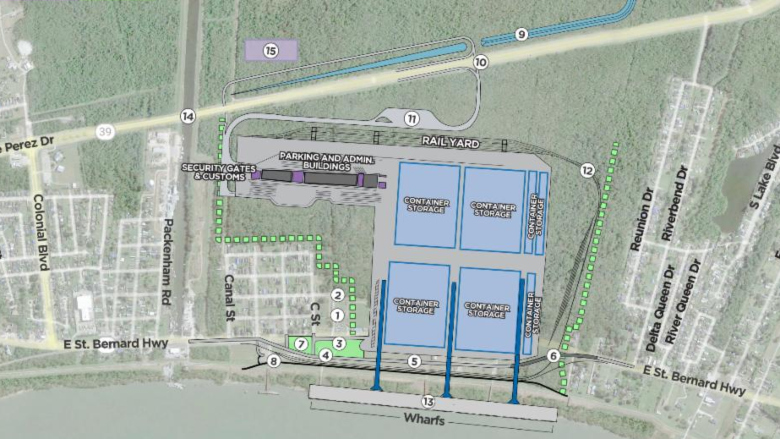Louisiana and the Port of New Orleans have opted to use a public-private partnership (P3) to deliver the planned $1.8-billion Louisiana International Terminal container facility. They will work with terminal operator Ports America and the development arm of Mediterranean Shipping Co. to jointly build and operate it, Gov. John Bel Edwards announced Dec. 12.
Jersey City, N.J.-based Ports America and Geneva, Switzerland-based Mediterranean Shipping have committed $800 million toward the project, according to Edwards’ announcement. The P3 team aims to award a construction contract and begin building in 2025 to have the first berth open in 2028.
The terminal, which would supplement existing port facilities in New Orleans, would be built on a 1,200-acre site on the Lower Mississippi River in St. Bernard Parish. Container storage would account for most of the site. The plan also calls for construction of administrative buildings, a railyard and wharfs.
The port released an updated design in October based on feedback that keeps St. Bernard Highway along the river, using ramps over the road to connect wharfs to container storage areas. A new overpass would eliminate the need for a rail crossing on the highway. The update also adds more buffers between the terminal and surrounding neighborhoods, and expands plans for a system of drainage pumps and canals.
Even ultra-large container ships would be able to use the terminal because the site is downriver from any bridges, avoiding height restrictions. The port says the site could handle 1.2 million containers each year.
Tom Van Eynde, North America director for Mediterranean Shipping’s terminal investment unit, said in a statement that the expansion would make the port “a key facility in the Gulf of Mexico capable of handling ultra-large container vessels.”
He said container trade at the port now "mainly consists of export cargo, making it an exception among U.S. ports, which are usually import-heavy, adding that the new terminal "will attract new container trades, providing access ... to cost-competitive shipping options.”
The U.S. Army Corps of Engineers is conducting an environmental review of the plan.





